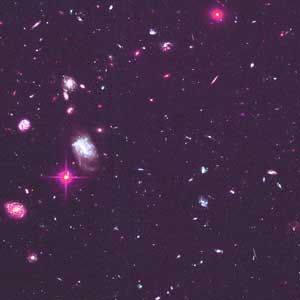Before you try answering sample test questions about the two texts in this lesson, brainstorm some similarities. For the questions that follow, see if you can select whether the stated quality or condition is similar or not similar in “When I Heard the Learn’d Astronomer” and “A Shared Vision to Dazzle Urbanites With the Night Sky.”
1. Both texts involve telescopes.
Similar
Try again.
Not similar
Correct! We might imagine an astronomer having a telescope in the lecture hall with him, but there is no mention of this in the poem.
2. Both texts involve audiences.
Similar
Correct! The lecturer gets “much applause,” so we have to assume a good-sized audience attends his lecture. As Jason Kendall tries to get people interested in looking at Saturn, “a small crowd gather[s].”
Not similar
Try again.
3. Both texts involve references to scientific information about celestial bodies.
Similar
Correct! In the poem, information is all that the astronomer has. He has plenty of “proofs,” “figures,” and “charts and diagrams” but nothing to offer in the way of direct experiences. In the article, Jason Kendall offers his audience both direct experience and information. For example, he informs them that Titan “looks like New Mexico, except it rains liquid methane.”
Not similar
Try again.
4. Both texts support the value of having a direct experience with nature.
Similar
Correct! In the poem, the point is that the “proofs” and “figures” are dead facts compared to the living experience of gazing “at the stars.” In the article, Jason Kendall’s project and Katja Aglert’s project are both intended to make people aware of the value of experiencing nature. Kendall says, “How can you appreciate something you’ve never seen?”
Not similar
Try again.
5. Both texts suggest that viewing the stars alone is important.
Similar
Try again.
Not similar
Correct! In the poem, the speaker suggests that being alone is important by using the phrase “perfect silence” to describe being “by [him]self.” In the article, however, there is no suggestion that “star gazing” is best done in solitude. Kendall gathers a crowd to look through his telescope, and Aglert proposes that her “night sky experience” take place in Times Square—one of the least likely places on earth for a person to be alone.
6. Both texts end with an awareness of the night sky by a single person.
Similar
Correct! In the poem, the speaker looks up “in perfect silence at the stars.” In the article, the last sentence is a quotation from Wsam Ottman who says, “I don’t believe it! Saturn really does have a ring.”
Not similar
Try again.
7. Both texts involve a criticism of technology.
Similar
Try again.
Not similar
Correct! In the poem, there is an implied criticism of scientific information replacing experience, but it is not a criticism of technology. In the article, there is a criticism of “too much light,” but Aglert says “The functional lights should still be on. But perhaps we can think about making less light.” Therefore, the criticism is not about the technology involved with artificial lights, but with the extent to which we use this technology.
8. Both texts involve an unconventional view.
Similar
Correct! In the poem, the speaker could be the only one who leaves the lecture hall. The lecturer is given “much applause” by his audience; therefore, we assume that what he is saying is a popular view of things. In the article, although Kendall can gather a crowd to look through the telescope, the author says that both Kendall and Aglert face “daunting challenges” to get their projects approved. Among other things, we might conclude that many people don’t want less light in New York City.
Not similar
Try again.
